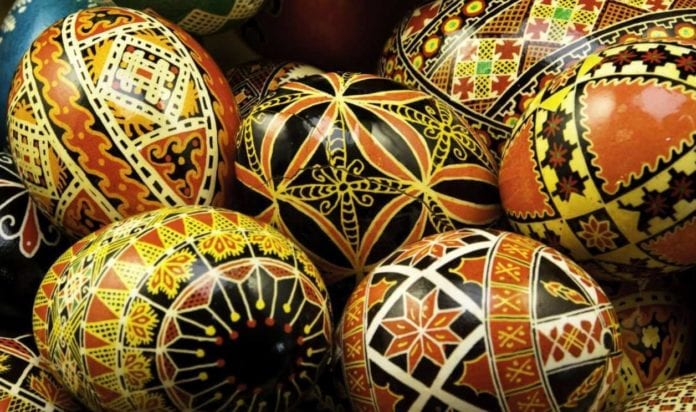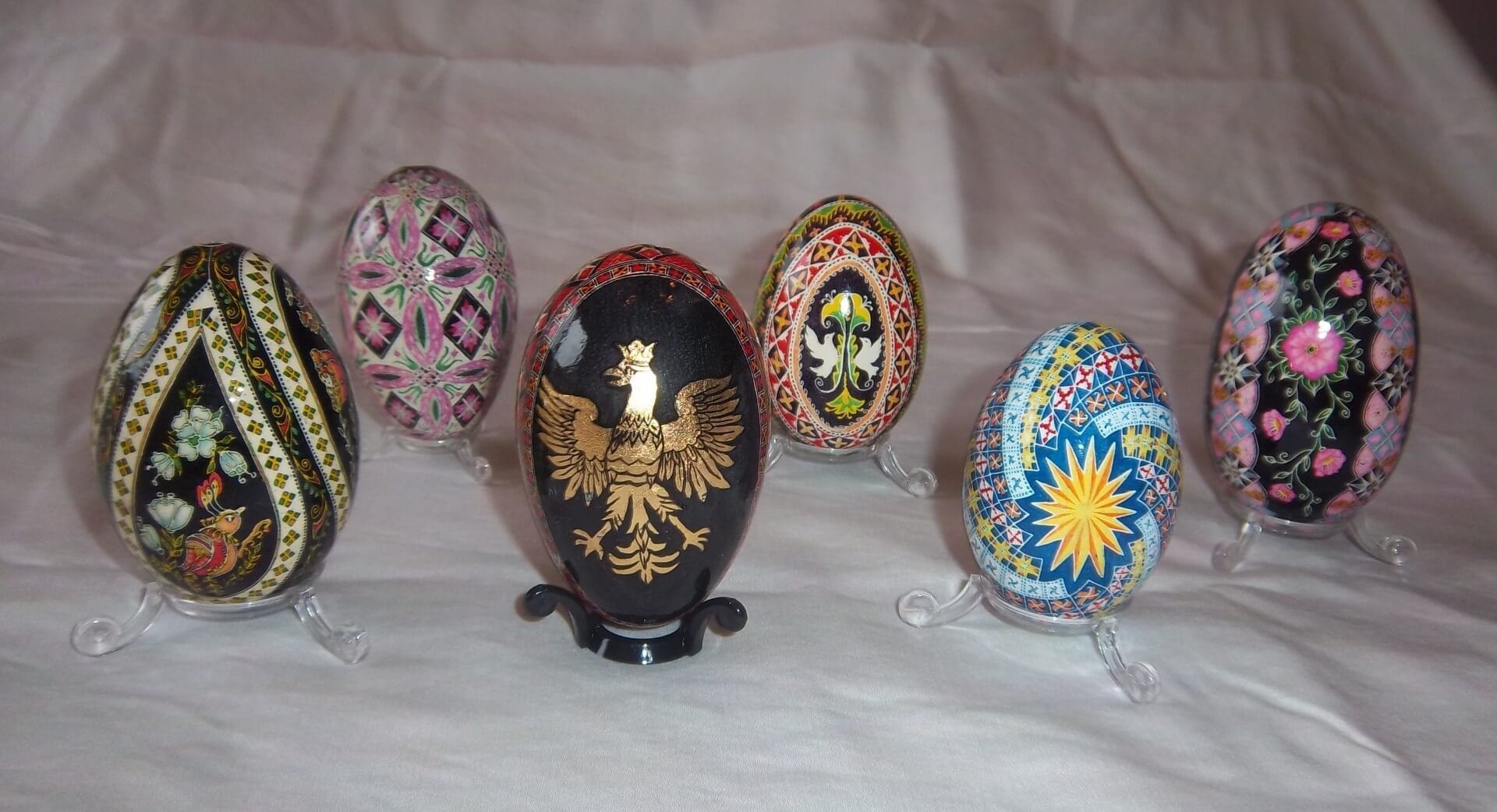When it comes to Easter in New Jersey, the Ukrainian culture does it right. While cooks are hard at work in Garden State kitchens making homemade breads, stuffed cabbage, and pierogies, artisans began working months ago on traditional crafts like embroidery, beadwork, and pysanky.
Mark Wojcik, a dedicated hobbyist from Howell, has been designing eggs using pysanky since the age of 5; Best of NJ reached out to him to learn the background behind this beautiful art.
This feature also includes some pysanky workshops in New Jersey, one of which Mark teaches, where readers can make their own eggs. For those so inclined, we’ve also listed a few Ukrainian Easter bazaars where ornately decorated eggs can be purchased.
[bibblio style=”bib–row-3 bib–hover bib–white-label bib–font-arial bib–default bib–size-16 bib–shine” query_string_params=”eyJ1dG1fc291cmNlIjoiQmliYmxpbyIsInV0bV9tZWRpdW0iOiJNb2R1bGUiLCJ1dG1fY2FtcGFpZ24iOiJSZWNvbW1lbmRhdGlvbnMifQ==” recommendation_type=”optimised”]
What is Pysanky?
 Pysanky is the Ukrainian art of designing eggs. When translated, pysanky means “to write.” The designs are written on eggs with hot beeswax using a pin head or a kistka tool. The eggs achieve their colors from assorted dyes.
Pysanky is the Ukrainian art of designing eggs. When translated, pysanky means “to write.” The designs are written on eggs with hot beeswax using a pin head or a kistka tool. The eggs achieve their colors from assorted dyes.
Mark Wojcik learned the Ukrainian art from his Grandma, who brought it from the old country. “It was popular to do in the spring time,” he said. “In the Ukraine, they have been doing this for thousands of years. Ceramic eggs have been found that are 4,000 years old. Pysanky reminded Grandma of home.”
His Grandma used very simple tools—some melted beeswax on a jar lid, a pencil with a straight pin stuck in the eraser to draw designs, and natural dyes from fruits, vegetables, and even crepe paper.
Today, Mark has modern dyes, design books, and electric tools at his fingertips.
Symbolism
There is much symbolism in pysanky. First, each color is symbolic. As Mark explains it, “White equals purity—it is the preferred color for giving to children—it is a blank background on which to write the rest of their lives. Black, on the other hand, is reserved for older people who have had a rich life. The different colors on the black stand out more. The egg chronicles all of their wisdom.”
All of the motifs on each egg have meaning as well. “Since this was started in the pre-Christian era, a lot of the symbols have pagan meanings. You will see netting on eggs. In the old days, it would symbolize the good catch of a fisherman. Later on, the Christians would say the nets symbolize those that The Disciples caught fish in. If a vine goes all of the way around an egg and joins to itself, it means eternity and a wish for long life. There are probably 30 to 40 different things you could go through and explain on an egg. Each egg has its own story.”
Though designs have evolved over the years, Mark mentioned his appreciation for the rich history of pysanky. “I absolutely love the old traditional designs—they are beautiful, flowing, and so meaningful. You have your geometric figures, flowers, animals, birds, the sun, plants, your symbols from Christianity—but I also enjoy coming up with modern designs. I have taken inspiration from Persian rugs, Japanese prints, even gardening catalogs,” he stated.
From Blank Shell to Art
 So how do you go from a plain white egg to a work of art? Mark starts with a blown-out white egg that has been cleaned and dried. When it comes to egg selection, he has used everything from very tiny and extremely delicate dove eggs, to parakeet, bantam, chicken, duck, peacock, goose, rhea, and even ostrich eggs. “A chicken egg can take 2-6 hours, depending on the intricacy of the design and the number of colors. A goose can be from 8-20, and a big rhea or ostrich can take 20-40 or more hours!” Mark mentioned.
So how do you go from a plain white egg to a work of art? Mark starts with a blown-out white egg that has been cleaned and dried. When it comes to egg selection, he has used everything from very tiny and extremely delicate dove eggs, to parakeet, bantam, chicken, duck, peacock, goose, rhea, and even ostrich eggs. “A chicken egg can take 2-6 hours, depending on the intricacy of the design and the number of colors. A goose can be from 8-20, and a big rhea or ostrich can take 20-40 or more hours!” Mark mentioned.
Next comes the electric kistka tool to apply the melted beeswax on the egg’s surface. Mark writes a design on the egg—whatever is under the wax remains white. When he is done with the initial designs, he selects the dyes—going from light to dark. An example would be going from yellow, to orange, to blue, then brown. Then the egg is covered in an ugly black wax. At this point, the egg is put next to a candle and the wax slowly melts off, revealing all of the colored designs.
Mark finishes each egg with a couple applications of Clear-Coat for protection and to add shine. He started this year’s pysanky process in January, and by Easter intends to have close to 32 eggs completed. As tradition dictates, he will hand them out to his family members and close friends.
Pysanky throughout New Jersey
A few times a year, Mark enjoys teaching a pysanky class at The Pink Elephant Pottery Studio, his sister Debbie’s studio in Asbury Park. Participants get to make an egg and learn the symbolism and rich history of pysanky. The class is $25.00 for adults and children ages 7 and up. For more info, call 732-229-7800.
Hero (Top) Feature Image: © / Dollar Photo Club
Additional Images (in Order) Courtesy:
Sun and Moon designs / Mark Wojcik
Goose eggs / Mark Wojcik
Mark at work / Mark Wojcik












